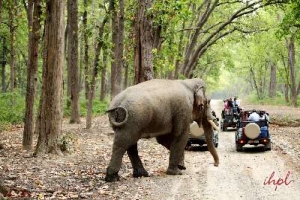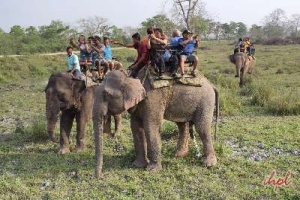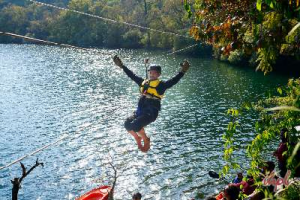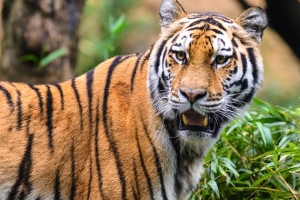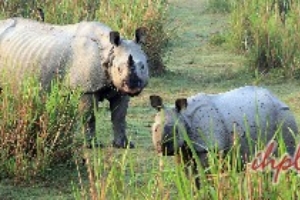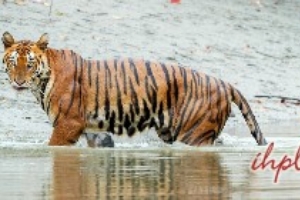Given below are some exciting encounters with Indian Wildlife and Corbett National Park Happenings. 2005 On May 26th at 11.30 pm Mr. Pandey of the KMVN restaurant in the Dhikala tourist complex closed his counter and walked back to his quarter. As he was in the process of opening his cabin door, he was attacked by a tigress who caught hold of his leg and dragged him to the jungle edge. On hearing his cries for help, other people in the complex ran to him. With the help of light from torches and vehicles headlights, they saw the tigress sitting on him guarding her potential kill. They started pelting stones on her, which she fended off with her paws, ducking, snarling, and growling all the time.
By this time guns were brought and when shots were fired near her, she left her quarry and moved back 10 yards and sat down. Mr Pandey was immediately spirited away, and is now undergoing treatment at a hospital in New Delhi. Till 4.00 am a furious tigress kept prowling around the complex. Till the park was closed for tourists in June, Dhikala was guarded in the nights, as the tigress kept visiting the complex. An electric fence has now been put around the complex.
2001
5 elephants were killed for their tusks, and a Deputy Ranger Mr Bipin Chandra Pandey killed by the poachers, during combing operations.
1988
In summer, the staff in Dhikala keep the doors of their quarters open in the night while sleeping, so that cool air can come in. In the summer month of May a tigress entered mahout Sher Bahadur’s quarters and attacked him. His screams attracted the attention of the Honourary Wildlife Warden Brijender Singh who was luckily staying at Dhikala at that time. He rushed to the quarters and after administration of first aid, had the injured man sent off by jeep to Ramnagar for medical treatment.
It was Major Ramsay, the officer in charge of this area, who in 1858 took the first step in arresting the wanton destruction. Farming was stopped and cattle were banned. Further a system was put into place where timber could not be removed without a license. In 1868 control of this area went into the hands of the Forest Department. In 1879 these forests became Reserve Forests which meant that felling of trees for timber was now restricted. This resulted in the forest and its wildlife showing signs of improvement.
The first proposal for forming a game sanctuary came in 1907 by Michael Keen an officer with the Forest Department. This was rejected outright. In 1916 and 1917 two forest officers, E.R.Stevens and his successor, E.A.Smythies made attempts to have it declared a game sanctuary.
The Field Director who was also there at that time, and Brijender Singh, decided to check out the area in their jeep, which had a spot-light. The staff were told to remain in their quarters and to keep the doors closed. As they drove off, the tigress pounced on another mahout Shafi while he was closing the door. She grabbed him by the neck and pulled him away. When the Field Director and Brijender Singh heard the people shouting ” Come back, the tiger is taking him away ” , they reversed the jeep and in the headlights saw the tiger standing over the man. While the injured mahout began to crawl away, Brijender Singh got down from the vehicle and killed the tigress with his pistol.
1985
In February British ornithologist David Hunt was killed by a tiger, while studying Indian wildlife in Corbett National Park.
1982
In March a fodder cutter, gathering fodder for the elephants, was killed by a tiger.
1980
The red-eared tusker, also mentioned under 1977, had killed 3 people, and took to attacking the temporary camps which were set up in the Corbett National Park. He was declared a killer elephant, and on March 28th it took ten bullets to finish him off.
1979
In March an elephant was found dead on the Dhangarhi – Ramnagar road, 2kms from Dhangarhi. It had died in a fight with another elephant. A large pit was dug and the body buried.
1978
In August two forest staff, were attacked by four bears, with two cubs, at Malani. At first the staff kept them at bay by pelting them with stones. A male bear finally attacked one of the men, clawing and biting him. The other man picked up a heavy stone and with all his might threw it at the bear, hurting it badly. Howling in pain, he bolted into the jungle with the other bears. In the same year another bear attacked a patrol and mauled one of the men till it was chased off by blows from a stick.
1977
In the park there was a red-eared elephant who was also a rogue. In June he followed a car on the Khinnanauli Road for 7 kms. It was only when the car reached the Dhikala complex that he gave up. In the monsoon period, a tiger killed another tiger in a fight, and then ate both rear legs of his dead opponent.
1973 – 1977
There was a wild boar called Buddhu which used to hang around the Dhikala complex, eating the garbage of the kitchen. As people also used to feed him, he became bold and started searching the tents and sleeping bags for eatables ( At that time tents were there in the complex. Its been stopped). As he caused a lot of damage, it was decided to capture him and relocate him to Paterpani, a place 10 kms away. Before this plan could be implemented he fell ill and passed away.
1974-75
Five elephants were killed in Paterpani through electrocution, when an electric pole fell down, and they came into contact with the live wire.
1974
During the monsoons, an electric pole fell down and a ‘ makhana ‘ (male elephant without tusks) got electrocuted and died, when it came into contact with the live wire.
A multipurpose dam, Asia’s largest earthern dam, was built across the Ramganga River at Kalagarh. This led to 80 sq km of prime wildlife country being submerged, which included some of the best grasslands viz the Buxar Chaur and the Beri Chaur.
The result was catastrophic for the indian wildlife in Corbett National Park. The swamp deer became totally extinct, and the populations of spotted deer, hog deer and Indian porcupine have been severely affected by the inundation of the grasslands. Also, a large number of chital who had moved to higher ground, died. While the reasons for their death are not known, it is suspected that the cause might have been a liver fluke introduced by snails into the lake waters, and which these animals drank. Further, as the water of the reservoir had cut off the traditional migratory routes of the elephants this has lead to these gentle giants becoming short tempered.
1973
In March an adolescent elephant and a young cow got enmeshed in the live wire of an electric pole that had fallen, and died instantly.
1971
In July during the monsoons, electric cables snapped from an electric pole at Paterpani. A tusker passing by got electrocuted and died instantly.
The hazards of forest guard work
Harish Chandra Dhyani, a Corbett guard, was once walking through the park in the evening when he got the feeling that he was being followed. While he could not see anything, on backtracking he found a tiger’s pugmarks over his footprints. He quickly climbed a nearby tree and spent the night on it. When he got down the next morning, he found the tiger’s pugmarks all around the base of the tree.



